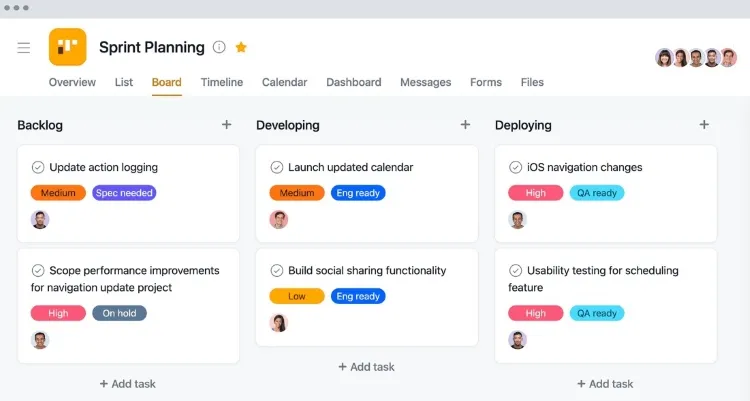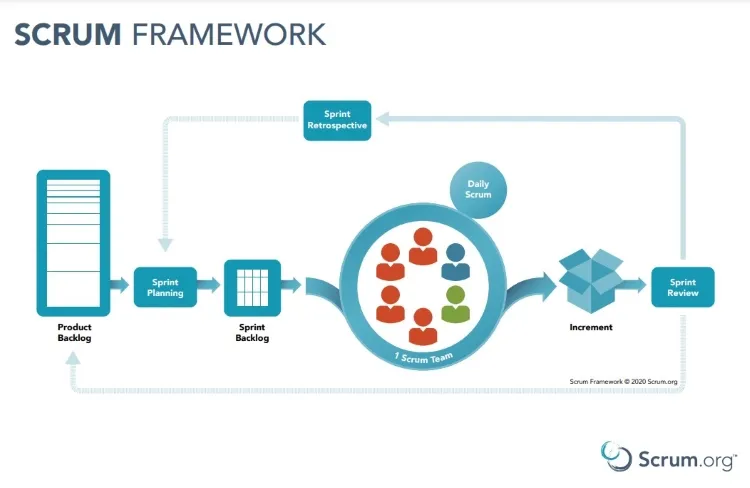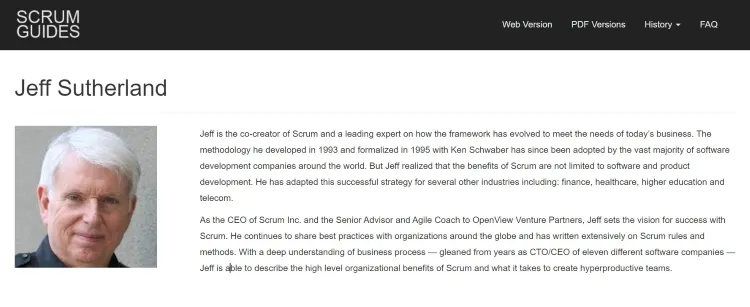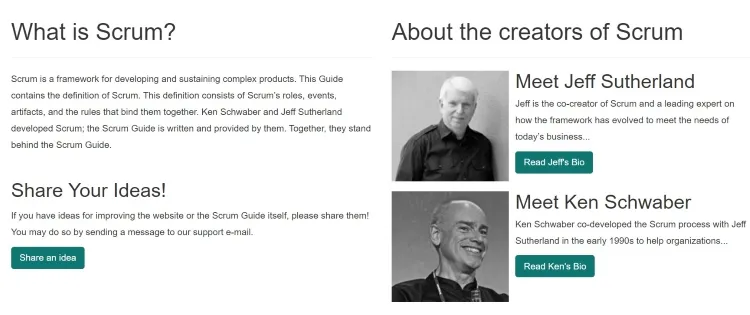Undoubtedly, for people who work with agile methodologies, terms such as Certified Scrum Master, Story Points, Scrum Guide, Sprint Grooming, Sprint Planning, Sprint Retrospective, Scrum methodology, and Scrum Framework are familiar.
Let's note immediately that the Scrum Framework is a term that, from among them, is the most general one that encompasses the others.
And as a side note.
For a language purist and a Scrum expert, the combination of the words Scrum and Framework will sound like a tautology, a type of language structure in which juxtaposed words duplicate their meaning.
Scrum — let's preempt its definition and meaning — is, after all, a framework. In this article, we will explain precisely what this means.
As for now, we'll add that this juxtaposition is pretty popular. Hence, you don't have to succumb to linguistic purism; you can understand and accept it. There is no need to fight the common usage.
Ultimately, it's not about linguistic correctness but about understanding the meaning of the term, the scope of its usage, and the practical benefits stemming from the use of agile methodologies.
This is the core we want to focus on.
In this case, we'll focus on one of the agile methods within which Scrum is a structure, skeleton, and mode of operation.
Or speaking in a native tongue for this method, it's simply a framework.
When it comes to using agile methodologies, it's worth remembering that an agile team doesn't have to use Scrum. However, a Scrum team will use the agile philosophy.
Moving on to specifics, in this article, we'll "decipher" what hides behind the term Scrum Framework.
We'll look at related terms that are the essence of Scrum — their meanings, usage, and, primarily, benefits that development and design teams gain when using the Scrum Framework.
So, if you're curious about what the agile methodology and its most popular framework Scrum have to offer, then take a few minutes to read the following article.
Scrum Framework — what is it?
Scrum is a term used by rugby players and trainers.
In the context of IT project management, it appeared in 1986 in the article published in Harvard Business Review in which authors Hirotaka Takeuchi and Ikujiro Nonaka noticed the possibility of using (naturally after adaptation and development) methods used by rugby players in IT projects.
In English, the word framework means a particular frame, skeleton, structure, or way of connecting elements, a certain context, or a model of something.
So, this word refers not only to how something is built but also to how it works, according to what logic.
When we talk about a Framework, we mean a way of organizing (e.g., tasks, roles, processes, procedures) and the principles, norms, values, and goals that govern them.
That's how things look when we combine the words Framework and Scrum. The combination Scrum Framework should suggest that it's about a methodology.
A methodology is nothing more than a particular determined and finite collection of principles. With such a collection, you can determine the methods and tools that will be used to perform work. These principles refer not only to "what" but also to "how," "in what way," "with what," "through what," and "with what effect."
A methodology also relates to the educational aspect because it's also a detailed description of a way of teaching.
After these initial and necessary remarks, it's time to define the Scrum Framework or, rather, what Scrum is.
In the article "What is scrum," published on the Atlassian blog, Scrum is defined as a "framework that helps teams structure and manage their work."
To help readers and adepts of agile methodologies better understand the meaning of this concept, the authors of this article use a very illustrative metaphor.
Namely, it reads as follows:
"Much like a rugby team (where it gets its name) training for the big game, scrum encourages teams to learn through experiences, self-organize while working on a problem, and reflect on their wins and losses to continuously improve."
According to a more formal definition of Scrum published in the Scrum Glossary, Scrum is a framework supporting development and design teams in the detailed and complete development of digital products.
Scrum consists of Scrum Teams and roles related to them (e.g., Scrum Master), events (e.g., Sprint Retrospective), artifacts, and principles that are used in line with the definition described in the Scrum Guide.
Another context — significant in terms of the idea, spirit, and practices of agile methodologies — of understanding Scrum can be found in the article "What is Scrum?," published on a dedicated Scrum platform Scrum.org.
Authors affiliated with Scrum.org add to the above definitions elements that underlie what makes Scrum what it is.
In a strict sense, it's not a methodology, although it's based on scientific empiricism. And more importantly, "Scrum replaces a programmed algorithmic approach with a heuristic one, with respect for people and thriving on the self-organizing capabilities of people to deal with unpredictability and address complex challenges."
It's still not everything that can be written about the Scrum framework.
A characteristic trait of Scrum is also cyclical meetings (ceremonies):
- Daily Stand-ups/Daily Scrum
- Backlog Grooming
- Sprint Planning Meeting
- Scrum Retrospective.
Scrum Framework is not just a process that increases the probability and significantly facilitates the production of a high-quality digital product within the specified time and budget.
Scrum is a structure, a frame of this process, meaning that it's used to avoid typical problems and to solve them.
Typical because you can't think about it as an omnipotent tool; it's as useful as imperfect.
In summary, we have a lightweight framework in mind whether we use the term Scrum (which is correct and recommended) or Scrum Framework (which isn't recommended but is acceptable).
We think about the structure of roles, norms, values, and goals, which allows development, programming, and design teams to solve complex problems and create high-quality digital products effectively and efficiently.
The most important characteristics of Scrum
Scrum gained popularity mainly because of its attributes and benefits that come from using it.
Its popularity is a product of the following:
- Big, tangible, and directly noticeable benefits
- Ease of use
- Speed of learning its fundamental principles and rules
- Universal application.
Above else, Scrum is:
- Easy to understand
- Focused on people, thanks to which it can streamline the work of multi-person, multi-functional teams with diverse competencies and responsibilities
- Based on cooperation and has iterative and incremental character, which enables better work and project management
- Founded on clear and rational principles
- Ensures a holistic approach to digital product development and project management
- Clear and flexible
- Based on continuous learning and improvement, mainly through the consistent use of feedback
- Effective and efficient — allows you to significantly simplify and shorten the path and time needed to implement ideas.
The main trait of Scrum is the idea of dividing large fragments of tasks, activities, and work into smaller ones and completing them during Sprints, specifically defined in terms of the scope of work and time intervals.
Another very important characteristic of Scrum is the use of feedback and feedback loops, thanks to which the work, processes, effects, and products are even better, risks are reduced, and errors are limited.
According to The Scrum Guide, Scrum is a framework that helps teams create values through adaptive solutions to complex problems.
What's equally important, Scrum is based on heuristics. This means that teams continuously learn and correct their mistakes; they adapt to changing situations and conditions.
The team starts the project under conditions of limited knowledge, and during it, it broadens its scope, depth, and complexity.

The essence of Scrum is the naturalness and obviousness of the need to adapt to changing conditions and react to the evolving requirements formulated by users and stakeholders.
The above characteristics may give rise to perceptions about a rigid method that is dogmatic. Nothing could be further from the truth. Scrum is flexible and has a clear, rational, and readable structure.
Moreover, Scrum is so flexible that it's possible to adapt it to the specific needs of a given organization.
With that said, regardless of how an organization will use Scrum every time, the priority will be:
- Clarity and maximally concrete communication
- Transparency of principles and norms
- Increase in engagement.
Now, with the general idea about what Scrum is, it's time to briefly discuss its elements and indicate, describe, and explain its main concepts.
It's also worth bearing in mind that ceremonies are of extraordinary importance to the success of a project.
All or almost all of the essential advantages of a consistent approach to Scrum ceremonies were collected by Anna Kaley in the article "UX Responsibilities in Scrum Ceremonies."
The author affiliated with Nielsen Norman Group very astutely notices that omitting ceremonies is unfavorable.
Namely, it's about the loss of the following:
- Possibility to see the bigger picture
- A vision of the product
- Sense of common goals that should be shared among all team members
- Ability to see some of the problems in time
- Priorities that should be implemented in subsequent Sprints
- Ability to discover where additional work is needed.
Artifacts in Scrum
Let's start by introducing the meaning of the word artifacts. According to the dictionary definition, artifacts are everything that a human creates.
In Scrum, there are three main artifacts:
- Product Backlog
- Sprint Backlog
- Increment in line with the Definition of Done (DoD).
A Product Backlog is a list of work kept by a Product Owner. However, it's not a list with random items; it needs proper order and structure.
It includes tasks, actions, and elements that need to be done to create a digital product that aligns with individual stakeholders' expectations.
A Product Backlog is a starting point for creating a Sprint Backlog; we'll write about it in a moment.
The Product Backlog isn't an unchaining list; it has a processual character. It constantly changes and transforms; new information, problems, goals, and expectations continuously appear.
A Sprint Backlog is a list of User Stories (we wrote more about User Stories in the article "User Story acceptance criteria") that will be implemented in an upcoming planned Sprint.
Before every Sprint, the team collectively determines the scope of work that will be undertaken within it. The Sprint Backlog is a list far from dogmatic rigidity, but as a rule, the scope of Sprint shouldn't be changed during its course.

The goal of every Sprint is Increment — implementation of specific elements and functionalities.
The Increment has synonyms and related terms. In the context of Increments, terms such as Milestone and Sprint Goal are sometimes used.
Increment occurs when given elements, functionalities, or User Stories meet the Definition of Done.
Artifacts in Scrum are mainly used to ensure the continuity and purposefulness of the process and to gain confidence that the process is running smoothly.
They're also essential from the perspective of understanding the goals and methods of the project by all team members.
Roles in Scrum
As we've mentioned, Scrum is a structure, a structure of roles that determine the scope of actions, responsibilities, and obligations.
The Scrum team consists of the following roles:
- Product Owner
- Scrum Master
- Scrum Team (Development team).
Product Owner is one of the key roles in Scrum. Above all, they are a representative of the end customer and/or stakeholders.

A Product Owner is responsible for creating User Stories and simultaneously managing them in the Project Backlog. They define the dependencies occurring between them and give them adequate priority and rank.
The Product Owner is also responsible for defining and announcing releases, managing the backlog, and above all, taking care of their visibility.
Their task is to ensure maximal transparency of the Product Backlog and provide comprehensibility of individual items in the backlog for all Scrum team members.
A Scrum team (Scrum development team), in most cases — naturally, it depends on the size, complexity, and character of the project and digital product — consists of developers (front end and back end) and testers.
Development teams working in Sprints are primarily independent in organizing and planning their work. Their basis is self-organization, which also aims at self-improvement, self-awareness, and self-reliance.
A role of a Scrum Master is to organize the project on the highest, the most general level of complexity.
A Scrum Master is a facilitator. Their main goal is to improve communication and information flow and maintain a common perspective.
It also helps create the Product Backlog and determine the Definition of Done (DOD). They also lead daily Scrum meetings, Sprint Retrospectives, and Sprint Review.
What is the main objective of dividing roles and delegating tasks to particular people?
The division of roles in projects created in agile methodologies aims to improve the workflow, maximize its efficiency and harmonize actions, goals, means, and tools.
It supports productivity, safety, a good atmosphere that should exist in the team, and better communication.
A ship is a good metaphor for a Scrum team where everyone has a specific, concrete role and function.
The ship requires a helmsperson who knows where to go — the Product Owner performs this function.
For the ship to sail at a certain pace, at a certain speed, and in a trouble-free manner, an efficient mechanic is necessary — the Scrum Master fulfills this role.
A development team, on the other hand, is putting the ship in motion.
In other words, Scrum Master is a leader of a Scrum team; they direct it. Product Owner ensures that every team member works according to agile practices, thanks to which "delivering" the product is much easier and trouble-free.

It's also worth emphasizing that the Scrum team works according to the idea of self-organization and self-improvement.
In achieving these goals and ideals, the principles that play an essential role in agile methodologies, including in the Scrum framework, are extremely helpful.
Scrum principles
The incremental nature of agile methodologies, including the Scrum framework, allows you to control the risk more effectively, reduce errors, optimize processes, and improve workflow.

Effectiveness is ensured by Scrum's five core values (principles), which form the core of Scrum.
These Scrum values include the following:
- Commitment
- Focus
- Openness
- Respect
- Courage.
The article "10 Most Frequently Mentioned Basic Rules in Scrum" is an excellent supplement to the above list because it translates general, somewhat abstract values into concrete terms.
Mainly, the principles refer to the standards that should be realized regarding the organization of Sprints that:
- Shouldn't be longer than four weeks
- Shouldn't be separated from each other
- Should last the same amount of time
- Should be oriented toward a realistic goal — possible to deliver.
Furthermore, during Sprints, you should pay special attention to the following:
- Planning
- Sprint retrospective
- Sprint review.
Similar principles can be formulated regarding creating and maintaining the Product Backlog. We wrote more extensively about management, optimization, and best practices in the article "Sprint Grooming."
Definition of Done
In agile methodologies, it's essential to clearly define when and after fulfilling which conditions a given functionality or system element can be considered complete.
More importantly, for every team member, the status "done" should mean exactly the same thing.
The Definition of Done should have a group/team character. What does it mean?
It's about achieving the maximum unambiguousness. The certainty that a given function or element is done is vital because it allows the team to, among others, properly manage the Product Increment and plan the next Sprints.
Scrum Framework. Summary
- Scrum is a structure, skeleton, a model of operation.
- Scrum is a framework within a broader agile methodology.
- The term framework means a frame, a skeleton, a structure, a way of connecting elements, a context, and a model of something.
- Framework refers not only to how something is built but also to how it works, according to what logic.
- When we talk about a Framework, we mean the way of organizing (e.g., tasks, roles, processes, procedures) and the principles, norms, values, and goals that govern them.
- According to the basic definition, Scrum is a framework of procedures that makes it easier for development and design teams to work together.
- Scrum encourages teams to learn from experience, self-organize while working on a problem, and reflect on successes and failures for continuous improvement.
- The Scrum process consists of Scrum teams, Scrum roles, Scrum events, Scrum artifacts, and Scrum principles that are used and performed as defined in the Scrum Guide.
- Scrum is also used to avoid typical problems and solve them.
- An important characteristic of Scrum is the use of feedback and feedback loops, thanks to which the work, processes, effects, and products are even better, risks are reduced, and errors are limited.
- Scrum is based on heuristics — teams continuously learn and correct their mistakes; they adapt to changing situations and conditions.
- Artifacts in Agile, Scrum are mainly used to ensure the continuity and purposefulness of the process and to gain confidence that the entire process is running smoothly.







